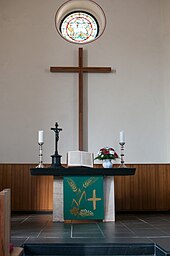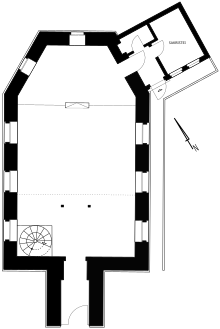Medebach Evangelical Church
The Protestant church is a listed church building in Medebach in the Hochsauerlandkreis ( North Rhine-Westphalia ).
history
The history of the church is closely related to the history of the parish. After the abolition of the spiritual principalities and denominational isolation in 1804, the first Protestant Christians moved to the Medebach area. When the congregation was founded on January 22, 1837, it had 149 members in 16 other villages in addition to Medebach. At that time, the service was celebrated in the "Turkish Hall" of the Schetter Inn. In 1838 the presbytery applied for a house collection in the whole province of Westphalia for a church to be built. This collection brought 1700 thalers, 400 thalers were given by King Friedrich Wilhelm III. , and 100 thalers came from the Soest Synod, to which Medebach belonged. This made 2200 thalers available for building the church.
In January 1839, three parcels at the corner of Oberstrasse and Nordwall were acquired as building land, so that the foundation stone for the church could be laid in spring 1839. The available funds were sufficient for a nave without a tower, gallery and organ. The new church was consecrated on October 25, 1840.
In the years 1842 to 1844, the parish tried to install a gallery for a small organ. The first organ came from the Oestreich company near Fulda. The church was spared the great city fire on May 25, 1844, in which 141 buildings were destroyed.
For the 25th anniversary in 1862, the community received rich gifts so that the tower could be built. A 23 m high quarry stone tower was built, with a gilded cross on a pommel at the top.
Shortly after the construction of the church, the presbytery dealt with moisture damage on the list. In a protocol from 1848, for example, it is stated that the church is damp inside and the cornice and plastering is damaged on the outside. This was traced back to the hygroscopic graywacke masonry and the lack of sills.
The roof of the church and the three large windows on the east side were damaged in the city fire from May 26th to 27th, 1900, in which 25 houses fell victim to the flames. The six tall windows were renewed in the same year by the company Victor von der Forst from Münster.
The first major renovation was carried out between 1959 and 1960. The preacher's chair has been removed. In its place there was a breakthrough to the sacristy. The wooden altar was replaced by one made of stone, an octagonal baptismal font was built in, and the wooden pulpit was also placed on a base made of shell limestone. A simple wooden cross was placed above the altar. This meant that van Oort's oil painting on the rear wall of the choir had no more space in the church. The gallery was expanded and provided with a spiral staircase as a staircase. The base of the nave was paneled with wood. An electric heater was also installed.
During the second renovation in 1989, the church was excavated 50 cm deep in order to master the still existing moisture in the masonry. Drainage was laid and the masonry insulated. The interior of the sanctuary was enlarged and the step around the altar removed. Electric underfloor heating was installed and the flooring was made of slate. A niche was created next to the pulpit, in which the silver chalice, the paten and the matching canister as well as a brass-bronze baptismal bowl can be found. The grating in front of the niche was created by the blacksmith Willi Schütte using the old Kirchfirstspitze. The new interior painting of the plastered areas was kept in old pink.
Church building
The triaxial hall church with three-Sechstel- circuit was built from 1839 to 1840. The quarry stone masonry and the wooden beam ceiling are plastered, the walls are structured by arched windows. The interior has 110 seats. The window sills and the floor were made of slate . The west tower was only added in 1864. The tower has three bells. The church has been a listed building since 1984.
Furnishing
organ
The first organ in the church was built in 1835 by Adam Joseph Oestreich (1799–1843) from Oberbimbach near Fulda , a member of a well-known family of organ builders who worked for five generations. This organ was used for over 100 years and was replaced by an electronic organ in 1960 as part of the church renovation at that time. In 1974 this was replaced by a new organ from the company Führer from Bremerhaven. The new organ with six registers and a manual was set up asymmetrically on the south side of the parapet and thoroughly revised during the renovation in 1990.
Bells
The first bell of the Protestant church in Medebach was given to the community by the landowner Waldeck in 1851. He had bought the bell for 20 Reichsthalers. This bell was the former "choir bell" of the Glindfeld monastery , which had become vacant as a result of the secularization of the monastery. The bell, weighing only 12 pounds, was sold on September 9, 1854 for 6 Reichsthalers.
After the completion of the church tower in 1864, the casting of two bells was commissioned from the Heinrich Humpert bell foundry in Brilon . One bell was 650mm in diameter and weighed 339.5 pounds, the other was 168.5 pounds. After the smaller bell burst in 1904, it was cast over by the Humpert company. The new bell had a mass of 329.5 kg and a diameter of 800 mm.
During the First World War, the remaining bell from 1864 was pulled in and destroyed in 1917. In 1925 a new 190 kg bell was cast by Junker & Edelbrock as a replacement for this bell. During the Second World War, the bell that was cast in 1904 had to be handed in in 1942.
After the war, the church received a loan bell from the Hamburg bell warehouse in 1951. This bell comes from Groß-Plauth, Rosenberg district in West Prussia . It was cast in 1606 by the bell caster Gerdt Benningk in Danzig . In 1942 it was confiscated but not destroyed. Due to the political situation, the bell could not be returned to its home country.
In 1963, a new bell was cast in three parts. The new bell was cast by the foundry Gebr. Rincker in Sinn . Since then, the following bells have hung in the tower of the church:
| No. | Casting year | Foundry, casting location | Diameter (mm, approx.) |
Mass (kg, approx.) |
Chime | comment |
|---|---|---|---|---|---|---|
| 1 | 1606 | Gerdt Benningk, Danzig | 751 | 250 | h 1 | Shoulder inscription:
LAUDATE DOMINUM IN CIMBALIS BENESONNATIBUS (SIC!) ANNO 1606 Inscriptions: |
| 2 | 1925 | Junker & Edelbrock, Brilon | 692 | 190 | d 2 | Inscriptions:
Cast by Junker and Edelbrock for the Evangelical Church Community of Medebach, |
| 3 | 1963 | Gebr. Rinker, Sinn | 636 | 150 | e 2 | Shoulder inscription : O LAND, LAND, LAND HEAR THE LORD'S WORD |
The sign » / « in the inscriptions stands for a line break.
literature
- Paul Michels, Nikolaus Rodenkirchen, Franz Herberhold: District of Brilon . Ed .: State curator Wilhelm Rave (= architectural and art monuments of Westphalia . Volume 45 ). Aschendorff publishing house, Münster / Westf. 1952, DNB 453372236 , p. 454 .
- Andreas Lechtape: The churches and chapels of the town of Medebach (= Small Kunstführer . No. 1140 ). 2., rework. Edition. Schnell and Steiner, Regensburg 2004, ISBN 3-7954-4863-8 , p. 27 (numerous illustrations and graphic representations).
- Evangelical Church Community Medebach (Hrsg.): Past and present. Evangelical parish Medebach 1837–1990 . Medebach 1990.
Web links
Individual evidence
- ↑ Evangelical Church Community Medebach (ed.): Past and present. Evangelical parish Medebach 1837–1990 . Medebach 1990, p. 19-24 .
- ↑ a b c Evangelical Church Community Medebach (Hrsg.): Past and present. Evangelical parish Medebach 1837–1990 . Medebach 1990, p. 25 .
- ↑ Evangelical Church Community Medebach (ed.): Past and present. Evangelical parish Medebach 1837–1990 . Medebach 1990, p. 111 .
- ↑ Evangelical Church Community Medebach (ed.): Past and present. Evangelical parish Medebach 1837–1990 . Medebach 1990, p. 26 .
- ↑ Evangelical Church Community Medebach (ed.): Past and present. Evangelical parish Medebach 1837–1990 . Medebach 1990, p. 37 .
- ↑ Evangelical Church Community Medebach (ed.): Past and present. Evangelical parish Medebach 1837–1990 . Medebach 1990, p. 48-53 .
- ↑ a b Evangelical Church Community Medebach (Ed.): History and Present. Evangelical parish Medebach 1837–1990 . Medebach 1990, p. 99 .
- ↑ Evangelical Church Community Medebach (ed.): Past and present. Evangelical parish Medebach 1837–1990 . Medebach 1990, p. 91 .
- ^ Lothar Westerholt: The churches and chapels of the city of Medebach. 2nd Edition. Schnell and Steiner, Regensburg 2004, p. 24.
- ↑ Gottfried Rehm : The organ builder family Oestreich . In: The Johann-Markus-Oestreich-Organ (I / 10, 1799) in the Evangelical Church of Fraurombach. Restoration documentation, created by Orgelbau Andreas Schmidt, 2014, pp. 4–10, here p. 7 ( PDF ). The year of manufacture of the Medebach organ mentioned here, 1835, is obviously not in line with the year of construction of the church.
Coordinates: 51 ° 11 '59.4 " N , 8 ° 42' 8.3" E





